Happy Camper Part Two!
What a night! It actually wasn’t too cold in our tents and sleeping bags, but I didn’t sleep very well last night. It was tough to wriggle all the way into my sleeping bag because we were a bit cramped in the tent. Since our Scott tent had been used as a cooking area, snow had been dug out of the middle and tossed outside. Although Dave and I worked to shovel snow back inside and level the “floor” area, once we laid down on that it compressed and created a rounded sink hole. I was in the middle of the trio of campers in our tent, so I was in the sink hole all night. I did have a spectacular view of the top inside of our tent. The water bottle that I filled with boiling water at bedtime had stayed warm until about 4:30 am. I know this because I was up so much throughout the night. That hot water bottle was placed inside my fleece shirt, against my long underwear shirt. It really did help keep my body warm. I needed a lot more water bottles though!
Dave and I were two Happy Campers after our condition 2 night outdoors. We found out later that winds had reached 51 mph and temps (with wind chill) were about zero. If you haven’t seen the videos I posted yesterday, I suggest you back up a day and read that blog. Notice that visibility is still not that great, but we were up and ready to work!
Everyone was up by about 6:00 am. We needed to break camp and be ready for Jen and Suz to pick us up by 8:30 am. What took hours and hours to create, came down much more quickly. Some people collapsed tents and packed them up while others started up the camp stoves and heated water for hot drinks and oatmeal. Our beautiful snow brick wall had a gorgeous drift on the south side. It did the trick and protected those expedition tents from the high winds.
The large Scott tent fits neatly inside of a canvas case. These tents are pretty heavy and it took 2-3 people to carry each one back to the storage area by the outhouses.
Once we had major tasks out of the way, we took some time to snap additional photos. In the photo below I’m inside of the opening of one of the trenches used by a Happy Camper in our group. Two brave souls slept in trenches last night. They reported that it was quiet and warm in those trenches. Personally I’d feel cramped and claustrophobic….so I don’t think a trench is for me, unless we were in an emergency situation.
Two hours after we got up, visibility was still not terrific, as seen in the picture below. We could see Ob Hill and Scott Base…just barely.
It was snowing lightly again and soon our orange bags were covered with a thin layer of snow.
Promptly at 8:30, we heard the buzzing noise of the snowmobile coming our way! Jen and Suz were ready to pick up the sleep kits, food storage boxes, stoves and other supplies and take them back to the I-Hut in their wooden sled/trailer on skis.
Back at the I-Hut, we could warm up a bit and even take off our big red parkas! We had a bit of a debrief session where everyone shared high/low points of camping out last night and also things that we learned from the experience. Desi had the best quote when she said: “It was an experience, I loved it, and I’ll NEVER have to do it again.”
Suz shared the contents of a large red survival bag, which must be taken on every trip that is off of base and regular routes. This bag contains supplies and food for two people to be out for three days. Let’s hope we never have to use those supplies!
Jen taught us how to use two kinds of radios; VHF (very high frequency) radios which are used within about 100 miles of the station, and HF (high frequency) radios used at deep field camps in more remote areas. When away from McMurdo Station, a safety net of at least two forms of communication (comms) are required. In this photo Jen is sharing how to set up the HF radio.
Indoor training for the radios was not enough, so we ventured outside again to set up the HF radio and make contact with another location in Antarctica. Our group got to call South Pole Station! The photo below shows how we set up the antennae on a long line perpendicular (not parallel, but like a capital T) to the location being contacted. We used bamboo poles to string up the antennae.
I volunteered to make the call to the South Pole. There is a certain protocol (procedure) used to make radio calls here. I used my “outdoor voice” as Jen called it, to speak slowly and clearly and said: South Pole, South Pole, South Pole; this is Happy Camper at frequency 7.5590; Over. A few seconds later, sure enough, a voice came over the radio and acknowledged our message. Our instructors told us to ask some questions. We found out that it was -16 degree F at the South Pole, that they had lamb shank for dinner last night, and that currently there are 181 people at the station. Once we signed off, our team packed up the radio gear and headed back inside.
The last activity we did was a search and rescue simulation. The scenario: one of our team members had gone out to the outhouse during whiteout conditions and hadn’t returned. Our “job” was to figure out a plan of action to rescue this person. White buckets were placed over the heads of our team members to simulate the whiteout. Each bucket had a funny face drawn on it. These faces were hilarious. Here is the search team leaving the hut. They’re roped together and that rope is anchored in the hut for safety.
This bucket head looks very serious about his/her rescue work!
As the team fanned out, they tried to locate the “missing person.” This technique could be used in a real-life situation. When we got back inside the hut, Jen and Suz talked with us about our plan, how it was implemented, and what the results were. Many suggestions for improvement were discussed and I felt the exercise was a really good learning experience. We had a good leader who took charge and tried to organize the search. The group didn’t do everything perfectly, but we all learned more about safety and what we might try to do in case this type of emergency popped up.
At 2:00 pm a Delta came to the I-Hut to pick us up and take us back to McMurdo Station. Snow flurries were still flying around and it felt good to be heading back to town.
The stencil that denotes the U.S. Navy is a leftover from the time when the Navy was in charge of logistics and activity here in McMurdo. Many of the vehicles have “names” on them. This Delta was called Gale. I’ve always wondered where some of the names came from and who they stand for.
Arrival back at the FSTP building did not signify the end of the course. We still had equipment to put away and prep for the next Happy Camper group going into the field. I joined the team replenishing the food supply in each of the two wooden storage crates. We counted every item and made sure there was enough for the new group. This included things like tea, coffee, hot cocao, candy bars, granola bars, soup packets, dehydrated meals for dinner, sugar, powdered milk, and oatmeal.
Our LAST part of the course was a video on helicopter safety which is so important around McMurdo. Helicopters are buzzing in and out of the station each day we have good weather. They transport people and supplies to scientists in remote field camps. After the video Jen ended the class by demonstrating how the two different types of helicopter seat belts worked. They are pretty different than your typical seat belt found in airplanes.
I was SO tired by this point that I could barely keep my eyes open! I couldn’t wait to get back to my dorm room for a HOT shower and then straight to the galley to eat dinner. I was thankful to be back in McMurdo, but I know we just had an adventure that I’ll not soon forget! Thanks to Jen and Suz for a safe, very informative and well-run Happy Camper training! I appreciate your expertise and friendliness throughout our class!



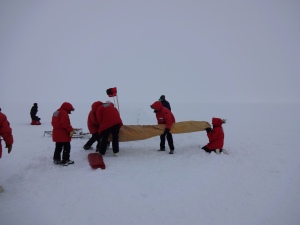
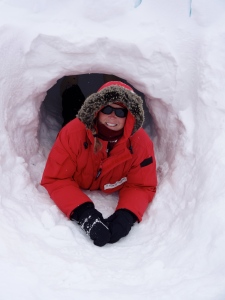
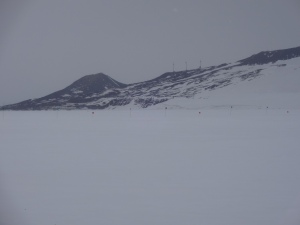
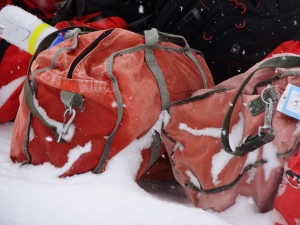
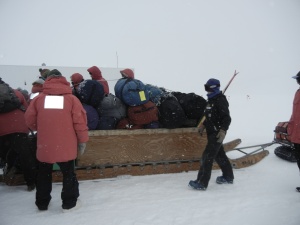
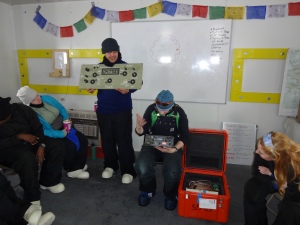


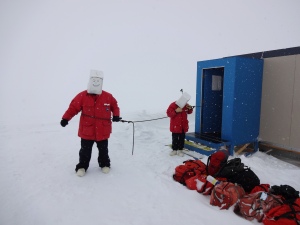


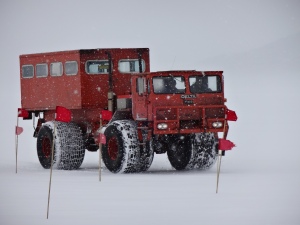


Good luck! We all are praying for your safety! ~Roe
Thanks Roe! Have a super day!
Wow!! That’s a little too intense for me!! So glad you are safe but that you enjoyed yourself as well!! I hope you are having a great day!
Love always
Cassie
Hey Cassie! GREAT to hear from you! Yes, while you are in warm Alabama, I’m down here enjoying much cooler temps, although yesterday it was about 35 degrees F. I miss you guys! Give Jackson a special hug from Grandma! Love Always, Betty
you are making me cold!goodness sakes!
Hey Beth! How’s the snow report for Steamboat? I’m actually wearing a Steamboat t-shirt right now! Miss you dear friend. Love, Boop
keeping up your usual pace, I see…
You betcha! Weather has improved since the camp-out and we’re back in the upper 30’s today here at McMurdo Station. Stay in touch, Sal.
wow cool and funny and lots of info its making my head dizzy and Jim half penny came lots of info fun and funny super funny he told us about the myth about the bear and tail you have so many friends around the world see like I said your the coolest and most traveliest teacher in the world your amazing
Hi Seif, I’m glad you enjoyed the presentation today by Jim Halfpenny. Did you know you can access his website from my blog (look on the right hand side and it’s the first one. (A Naturalist’s World) You are right, I love to travel around the world and learn new things. Keep on learning as much as you can. 🙂 Mrs. T
I have never been brave enough to winter camp before…you are so my hero now. Love that you had the spot in the middle with the hole…almost as bad as having that tree root under your tent. 😉 The search and rescue simulation was cool to read about and your call to the South Pole.
Betty, you are doing amazing work – thanks for sharing all the details with us. Much love to you.
My Mass Kicker class loved the weather video. They want to know how cold it gets at night and if penguins can freeze to death.
Hi Kim! The weather has been pretty variable here as always! The whiteout conditions and 51 mph winds, along with wind chill down to zero, led into a beautiful difference the following day. We had temps up to 35 degrees that day and yesterday it reached 39 degrees F ABOVE zero. By later in the day though it was much colder again and the winds had picked up, making it feel even worse. This morning it’s more cloudy than usual…who knows what that will mean for us today!
Penguins are specially adapted for this type of cold environment. I know that chicks could freeze and die if not protected by the warmth of the parents early on in their lives. They have the most densely packed feathers of any bird, and that protects them from the harsh environment. I’ll ask a penguin expert if adults can freeze and I’ll let you know when I write about penguins, very soon. Thanks for the questions!
I’ll definitely take the beach over the weather conditions you have. Then again, it is snowing hard here in Heidelberg. Had to cancel our evening plans with friends up in Wiesbaden as the roads are a mess. Snow plows are minimal here in Germany. Keep warm and stay safe.
LIOB
Hey Kathy! Snow in Heidelberg sounds lovely! Someday I’ll have to get there in the winter. I know you are a beach girl…most of my friends are! Stay warm in your cozy place in Heidelberg and keep on writing! It’s great to hear from you! LIOB
Hi Betty,
My Mol-e-cools class has many questions. They want to know your favorite part of the training and the trip. The would like to know both the most difficult and most dangerous part of the trip. Do you all get homesick? What is your most important tool? How long does it take to set up the camp? Do you set it up and take it down each day? How hard is it to get supplies? Finally, what animals do you run into?
Thanks.
Okay, here are some answers for you!
**My favorite part of the training was working together as a team to reach a common set of goals. I also loved that we experienced a real high-wind, white-out situation. It was tough, but a real Antarctic experience!
**I’ve seen some animals so far…Weddell seals that came up on the ice near McMurdo Station to lounge in the “summer sun” during this summer season. I’ve also seen some skuas around (sea gulls in this region). I’ve seen some great photos of penguins from my friend Jean Pennycook. She works with the scientist who is studying the Adelie penguins. I’ll write a blog on that soon and include some fun photos she took with my camera!
**The dangerous part of the trip could be frostbite or frostnip, falling into a crevasse (crack in the snow/ice), or if not following the directions you could fall into the ocean by being on an unsafe part of the sea ice. We have many training sessions to prepare us, and it’s important to always follow the flagged routes and directions here. Another danger could be machinery. It’s always important to be safe and pay attention when around machines and heavy equipment.
**Setting up the camp took hours, but in an emergency situation it could be done more quickly (and would be!). At our field camp later in the season, it will be set up for 2-3 weeks…we won’t have to take it down each day.
**Important tools in the field camps would be shovels, bamboo poles, ice axes, and a hand-held drill. At our WISSARD drill site there are MANY important tools and I’ll talk about those next week when the drilling begins.
**Supplies come in regularly on flights from New Zealand like the one I came down here on. Mail, fresh fruit and vegetables, science cargo, and many other items could be a part of each flight (as well as people). Supplies get to field camps by helicopter and small planes. It’s all a very well coordinated effort on the part of many people.
**I do get homesick and letters, emails, packages from home are SO appreciated and looked forward to. I’ve met wonderful new friends and I’ve seen some science friends from other projects, but nothing beats a message from family, friends, students, or YOU! It makes me feel connected to home!
Betty my Yellow Care Bears class would like to know how you got interested in this, and why you wanted to go there. They also want to know what is worse, the winds or the cold.
Hi Kim, before I forget, which school are you from and what grade level are your students? To answer your Yellow Care Bears group questions:
**I think the wind is worse, because then it makes it even colder, and it can get really hard to move around. The wind can knock you over and that has happened to me before in Antarctica! The wind cuts right through your layers of clothing. Brrrrrrrrrr!
**I have always been interested in geography and learning more about the Earth and it’s resources. I was interested in the outdoors from an early age. Antarctica and the Arctic have intrigued me, because they are so remote and unique. I was excited to get the opportunity to teach from Antarctica back in 1998 (my first of 3 times here) because it meant I could share this special place with others and teach everyone about it’s geologic history and the history of exploration in this region. Stay tuned for more information like this in my blogs!
Thanks for writing and asking great questions!
My Rockin’ Rockets class would like to know if the tents can blow over and what would happen if they did. They want to know how much food you take with you and how you store it. They would like to know what happens if someone needs real medical attention. Everyone want to know the coldest temperature you endure and how many layers of clothes you wear.
Yes, Rockin’ Rockets….tents CAN and DO blow over, which is why we had to work hard to anchor them with ropes attached to bamboo poles buried in the snow. Even then tents have blown over and can blow for miles if the winds are strong. Gloves, hats, supplies…basically anything that is not secured can go flying off along the ice and snow. The food is stored in heavy wooden boxes or coolers weighted down so they don’t blow away. The amount of food would depend on the number of people and the length of time they will be out in the field. We ALWAYS take way more food than you think you need…just in case of emergency.
Medical attention: if the person is here on base, we have doctors and nurses who work in the little McMurdo General Hospital. I’ll be writing a blog on that soon….so watch for that. If the person has a major illness or injury, they are sent back to Christchurch on a medivac flight as soon as one can be arrange. That gets tricky if a person is “wintering over” here in Antarctica. It is often difficult or impossible for people to be flown back for treatment. And, people have died in Antarctica…for many different reasons.
The coldest temperature I’ve experienced here (and it was on a previous trip, not this time) was -30 degrees F. With the wind blowing the wind chill was more like -40’s. It can get much colder though. I wear different amounts of layers depending on where I’m going and what I’m going to be doing. For Happy Camper school I wore sock liners, wool socks, bunny boots, two layers of long underwear, long undie shirt and a fleece shirt over that, my BIG RED parka, a neck gaiter, hat, gloves, and my sunglasses or goggles.
Thanks for your great questions!
Wow! How is the weather
Wow! Are you going to the lake? How big are the robot
My friends want to know if your going to the lake that has never been explored
Hi Jake, Which school are you from? Here are some answers to your questions:
** The weather here has been warmer than I expected for this early in December. Yesterday the temperature reached 39 degrees ABOVE zero. I think it was almost that cold in Crystal Lake where I live back home. But, by evening (even though it never looks like evening because we have 24 hours of daylight) it was windy and colder again. During my Happy Camper training it was brutally windy and cold. Weather can change here very rapidly, which is why we are always prepared with extra ECW (extreme cold weather) gear.
**We will be going to Lake Whillans (or above it really) later in the season. First we must test all of the equipment, including the hot water drill at a site near McMurdo Station. The drillers and scientists have to be sure that everything is working properly before we take the project hundreds of miles from McMurdo Station. And yes, to answer your final question, Lake Whillans has not been accessed or explored before. This will be exciting science news!
I am so interested in your work and I am reading your blog everyday at school and telling my friends all about it!!!! 🙂
Hi Baylee, What school are you in and what grade level are you? I’m glad you are enjoying the blog and following each day. If you have any questions, be sure to ask me. If I don’t know the answer I’ll try to find out for you! 🙂 Have a SUPER day!
WOW! it look really cool out there you should maybe put up pics of penguins!! 🙂 see you soon
Hi Lily, there will be photos of penguins very soon. Yesterday I gave my camera to my friend Jean, who works out in the Adelie penguin rookery with a scientist who has studied that colony of penguins for a long time. She took some awesome photos. I’m going to do an interview with Jean very soon. I haven’t seen any penguins near McMurdo yet….but they could wander near us at some point. At least I hope they do! 🙂
:):):):):):):):):):):):):) this blog is awesome
Thanks and keep on reading! Ask me some questions if you have some and please tell me which school you are from. 🙂
How are you doing in anartica ! It is so cool that you are in anartica!!!!!!!!!!!!!!
I’m doing okay here, Lauren, thanks for asking! I’m learning something new every day and it’s fun to share that with everyone through the blog. Keep on reading and learning!
Is it cold or warm
It’s cold. Tha is why she is wearing the heavy coat and boots.
Thank you, Baylee. Of course it’s VERY cold here compared to many places on this planet. But, I know my friends in northern Sweden have colder temperatures right now than we do in Antarctica! We have many later of clothing, and special big red parkas to keep us warm, but Baylee, you already know that!
Hi!!!!!!!!!!!!!!you are so lucky!!!!!!!!!!!
Yes, I know I am lucky and I am honored to have been chosen to represent the WISSARD Project as part of their education and outreach team.
How do u go to the camera that shows where u are staying???????
Click on the McMurdo Station webcam link on the right side of my blog page (it’s called the “Blogroll: section. You get a cool view of McMurdo Station that way! I eat all of my meals in that large blue building, called the galley.
Betty,
My C.A.R.L. (Cool and Radical Labs) class would like to know what government has control over Antarctica, if multiple, where you are.
They also want to know if it is hard to drive because it is so icy.
Thanks
Hi Kim and C.A.R.L. class, No government has control over Antarctica. It is protected by a treaty that was first signed many years ago. The treaty protects Antarctica for peaceful, scientific purposes. SCAR (Scientific Committee on Antarctic Research) helps to monitor the science projects hat go on down here, and there are strict rules and regulations to help monitor environmental concerns and procedures. Many countries have research stations in Antarctica including the U.S., New Zealand, Italy, Russia, and Australia in this region alone. More countries have bases on the other side of Antarctica, including Great Britain, Argentina, the U.S., Chile, and many more I’m sure I’m forgetting right now. Teams of scientists work all over the continent and they represent a wide variety of scientific projects, in earth, space, life, and physical science disciplines.
Driving can be a huge challenge here. Yes, it is slippery, but also very bumpy at times because of uneven surfaces of ice and snow. With warmer temperatures lately, the snow roads out to the WISSARD site have been difficult to maneuver. I know that some vehicles can get stuck and will need to be pulled out by heavy equipment. I’ve had some light vehicle and snowmobile training, but I’m not sure if I’ll get to drive a truck or van as part of our project. I have driven snowmobiles down here and I know from experience that you to have to be focused on safety at all times. Safety is a number one priority in Antarctica!
I love reading your blogs they are just so interesting!!!!! 🙂
Thanks Livie! Where are you from and what grade are you in? If you have any questions, please ask! I’ll try to get the most accurate response for you!
Hi Mrs Trummel I think your blog is so good I am wondering if can write back.
Hi Hannah, Yes, you can write back OR better yet, use trummelwissard@aol.com and write me an email message. Thanks for the positive feedback on my blog!
Like you I don’t think that I would like to sleep in a trench.
Willem B
Hello again, Willem…
Even though that trench was sturdy and well-constructed, I just do not like small spaces like that. It felt like a tomb to me! I’d take a tent any day!
Hi,Mrs.Trummel I think that it is cool that you could send a call all the way up to the south pole! I also found that it was funny that the rescue drill you did.I thought the drill was funny because of the silly faces on the buckets! The most silly face I thought was the serious robot face. Overall I liked that blog!
HI Charlie from 4-A….great to hear from you! I agree with you…. that radio call to the South Pole was really awesome! To think that we were talking on a radio to someone hundreds of miles away, across this snowy and icy continent….that’s amazing! I think you liked the same buckethead as I did. Even though it was a serious training exercise, the silly faces made it more fun. Glad you liked my blog. Keep reading and sending me comments and questions.
Hi mrs.trummel! We were wondering how do you know when to wake up in the morning do you have alarm clocks? Also we were wondering if you get hot or cold in the tents since you are crowded in there? Stay warm bye!
Hi Abbi and Jorge,
Good question! I use my cell phone (which doesn’t work down here, but makes a handy alarm clock). I’m usually sleeping a very warm dorm room. But, the night we camped out I was pretty warm except for my head out of the sleeping bag. I’ll be camping in a single-person tent once we get to the remote field camp in January. That should be pretty cold, but I’ll let you know. Keep reading my blogs and writing to me. Tell Mrs. Atkinson hello for me.